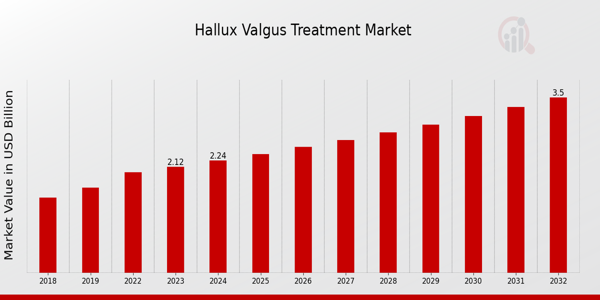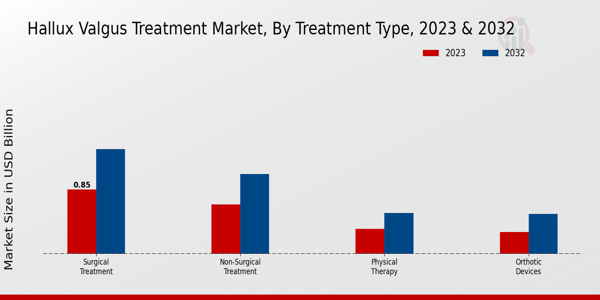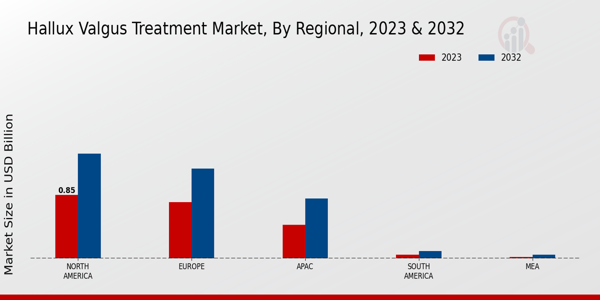Hallux Valgus Treatment Market Overview
As per MRFR analysis, the Hallux Valgus Treatment Market Size was estimated at 2.01 (USD Billion) in 2022. The Hallux Valgus Treatment Market Industry is expected to grow from 2.12(USD Billion) in 2023 to 3.5 (USD Billion) by 2032. The Hallux Valgus Treatment Market CAGR (growth rate) is expected to be around 5.71% during the forecast period (2024 - 2032).
Key Hallux Valgus Treatment Market Trends Highlighted
The Hallux Valgus Treatment Market is experiencing notable growth driven by several key factors. Increasing awareness about foot health, coupled with the rise in orthopedic disorders due to lifestyle changes, has led to a higher demand for effective treatments. The growing elderly population, who are more susceptible to hallux valgus, also contributes significantly to the market's expansion. Furthermore, advancements in surgical techniques and technology are enhancing patient outcomes, making surgeries safer and more effective. The availability of minimally invasive procedures is particularly appealing to patients seeking quicker recovery times and reduced discomfort.
There are numerous opportunities to be explored in this market, particularly in the development of innovative treatment options. New advancements in pharmacological treatments and custom orthotics can address specific patient needs. Additionally, expanding access to treatment in emerging economies presents a lucrative avenue for growth. As healthcare systems improve and awareness increases in these regions, the demand for hallux valgus treatments is likely to rise. Collaboration between medical device manufacturers and healthcare providers could also lead to tailored solutions that cater to diverse patient profiles. Recent trends indicate a shift towards patient-centered approaches in treatment planning.
Personalized medicine is gaining traction, allowing treatments to be customized to fit individual anatomical and lifestyle factors. Telemedicine and digital health tools are also emerging, providing patients easier access to consultations and follow-ups. Education campaigns aimed at preventing and managing hallux valgus are becoming more prevalent, further emphasizing the importance of proactive care. Overall, these trends signify a dynamic evolution in the hallux valgus treatment landscape, reflecting changing patient preferences and technological advancements.

Source: Primary Research, Secondary Research, MRFR Database and Analyst Review
Hallux Valgus Treatment Market Drivers
Increasing Prevalence of Hallux Valgus
The rising occurrence of hallux valgus among the global population is one of the most significant drivers for the Hallux Valgus Treatment Market Industry. Factors contributing to this increase include demographic shifts, lifestyle changes, and an aging population, all leading to higher incidences of this foot deformity. Hallux valgus often results in discomfort, pain, and impacted mobility, prompting many individuals to seek treatment options.
As awareness of foot health and the importance of seeking medical help grows, more people are likely to pursue interventions such as surgical and non-surgical treatments. Furthermore, the expanding middle-aged and elderly populations are particularly susceptible, as joint problems become more prevalent with age. This demographic shift creates a larger target market for treatment providers, thus driving growth in the Hallux Valgus Treatment Market Industry.
The combination of more sedentary lifestyles and the tendency of the elderly to develop orthopedic conditions further exacerbates the situation, prompting a surge in demand for effective and innovative treatment solutions. In addition, there has been a notable increase in the number of healthcare facilities and specialists focusing on orthopedic conditions, making access to treatment more prevalent. This overall trend is expected to shape the future landscape of the Hallux Valgus Treatment Market, providing numerous opportunities for growth as demand continues to rise.
Technological Advancements in Treatment Methods
Advancements in medical technology and foot surgery techniques are significantly influencing the Hallux Valgus Treatment Market Industry. Innovations in minimally invasive surgical procedures have led to improved outcomes, featuring reduced recovery times and lower risks of complications. Patients are increasingly favoring these advanced solutions, driving market growth as more clinics adopt cutting-edge technologies. The introduction of new devices and instruments designed specifically for hallux valgus correction has also enhanced surgical precision and effectiveness, promoting an uptick in procedures performed.
Growing Awareness and Behavioral Changes
There has been a marked increase in awareness regarding foot health and the long-term implications of untreated hallux valgus. Educational campaigns, both online and in healthcare settings, have empowered individuals to recognize symptoms and seek treatment earlier. This behavioral change is translating into higher consultation rates and, consequently, a greater demand for effective solutions. As the stigma around surgical treatment diminishes, more patients are willing to explore all available options, further fueling the growth of the Hallux Valgus Treatment Market Industry.
Hallux Valgus Treatment Market Segment Insights
Hallux Valgus Treatment Market Treatment Type Insights
The Hallux Valgus Treatment Market is set to evolve significantly, with a strong emphasis on different treatment types. In 2023, the market for Hallux Valgus treatment reached a valuation of 2.12 USD Billion, projected to rise to 3.5 USD Billion by 2032. The Treatment Type segment comprises various approaches, notably Surgical Treatment, Non-Surgical Treatment, Physical Therapy, and Orthotic Devices, each exhibiting different growth rates and market significance. Surgical Treatment is a dominant category, valued at 0.85 USD Billion in 2023 and expected to grow to 1.38 USD Billion by 2032, highlighting its role as a preferred option for many patients seeking long-term solutions for Hallux Valgus. The evolution of techniques and technology in surgical approaches contributes to its increasing preference, making surgical treatments highly significant in addressing severe cases.
Non-Surgical Treatment also shows considerable traction, with a market valuation of 0.65 USD Billion in 2023 and anticipated growth to 1.05 USD Billion by 2032.
This segment plays a critical role in treating milder forms of Hallux Valgus, which allows patients a choice between more immediate, less invasive solutions and surgical options. The growing awareness among patients about the benefits of non-invasive treatments drives this segment's growth. Physical Therapy, valued at 0.33 USD Billion in 2023 and projected to rise to 0.54 USD Billion by 2032, is gaining attention as it focuses on rehabilitation and preventive measures for Hallux Valgus. This segment provides patients with essential tools for managing symptoms and promoting strength in the foot without resorting to invasive procedures, thereby creating new opportunities within the market.
Lastly, Orthotic Devices, valued at 0.29 USD Billion in 2023, are expected to grow to 0.53 USD Billion by 2032. This segment is crucial because it serves as a supportive intervention for patients, allowing those who prefer non-surgical options to find effective relief. Orthotic devices are vital in both pre-operative and post-operative care, helping to stabilize the foot and minimize pain while enhancing overall mobility. The increasing demand for customized orthotic solutions reflects the overall trend toward personalized patient care, further solidifying its role in the Hallux Valgus Treatment Market revenue. In summary, the Treatment Type segment not only illustrates the diversity of approaches to Hallux Valgus but also underscores the continued growth and adaptation in response to patient needs and preferences across the globe.

Source: Primary Research, Secondary Research, MRFR Database and Analyst Review
Hallux Valgus Treatment Market Surgical Procedure Insights
The Hallux Valgus Treatment Market is experiencing significant growth, particularly in the Surgical Procedure segment, which has garnered considerable attention. In 2023, the market value was recorded at 2.12 Billion USD, reflecting the increasing demand for effective surgical options for hallux valgus. The market's growth is driven by factors such as the rising prevalence of foot disorders and advancements in surgical techniques. Within this segment, procedures like Osteotomy, Exostectomy, Arthrodesis, and Soft Tissue Surgery are vital in addressing varying degrees of hallux valgus severity.
Osteotomy, for instance, is commonly favored for its effective correction of bone alignment, while Exostectomy plays a crucial role in removing prominent bunions. Arthrodesis, on the other hand, is significant for patients requiring joint stabilization, and Soft Tissue Surgery addresses the soft tissue imbalances associated with the condition. The increasing preference for minimally invasive surgical options and advancements in technology further fuels the Hallux Valgus Treatment Market growth. However, challenges such as high costs and post-surgery complications may impact patient decisions and market dynamics. Overall, these insights reflect the evolving landscape of the Hallux Valgus Treatment Market and its segmentation focused on surgical procedures.
Hallux Valgus Treatment Market End User Insights
The Hallux Valgus Treatment Market is projected to reach a valuation of 2.12 billion USD in 2023, indicating a robust demand for effective treatment options across various end users. The segmentation within this market includes hospitals, orthopedic clinics, rehabilitation centers, and home care, each playing a vital role in delivering specialized services. Hospitals tend to dominate due to their comprehensive facilities and resources, providing a wide array of surgical and non-surgical treatments. On the other hand, orthopedic clinics focus specifically on musculoskeletal disorders, which makes them significant providers of targeted hallux valgus treatments.
Rehabilitation centers contribute to patient recovery and physical therapy, enhancing the overall success of treatment programs. Home care services become increasingly relevant, especially for patients preferring convenience and personalized care. The growth of the aging population and an increase in obesity rates are major growth drivers for the Hallux Valgus Treatment Market, while awareness and advancements in therapy options present significant opportunities. However, challenges like varying regulatory standards and patient compliance must be navigated to ensure successful treatment outcomes across these end-user categories.
Hallux Valgus Treatment Market Age Group Insights
The Hallux Valgus Treatment Market is a rapidly growing sector, particularly as it relates to the age group segmentation, which is crucial for understanding patient demographics and treatment approaches. In recent years, an increase in awareness regarding the condition has driven the market forward, reflecting the growing need for effective treatment options across various age groups. Pediatric patients highlight the importance of early intervention to prevent long-term complications, making this demographic significant for ongoing market growth.
Adults constitute a substantial portion of the market, often seeking correction to address both pain and cosmetic concerns, indicating a trend towards elective surgeries. The geriatric segment is also a major driver for market growth, as older individuals are more prone to Hallux Valgus due to wear and tear over time, necessitating treatment options tailored for their specific health conditions. Collectively, these age groups contribute significantly to the Hallux Valgus Treatment Market revenue, influencing trends in treatment methodologies and product development.
The challenges faced by healthcare professionals in managing treatment variances across these groups create ample opportunities for innovation within the Hallux Valgus Treatment Market industry.
Hallux Valgus Treatment Market Regional Insights
The Regional segment of the Hallux Valgus Treatment Market is poised for steady growth, reflecting a market value of 2.12 Billion USD in 2023, projected to reach 3.5 Billion USD by 2032. North America leads this segment with a market valuation of 0.85 Billion USD in 2023, which is projected to grow to 1.4 Billion USD by 2032, showcasing its dominance due to increased prevalence of hallux valgus and advanced healthcare infrastructure. Europe closely follows, holding 0.75 Billion USD in 2023 and expected to reach 1.2 Billion USD, driven by strong awareness and access to treatment options.
The APAC region, valued at 0.45 Billion USD in 2023, is also significant as growing economies increasingly focus on orthopedic care, with expectations of reaching 0.8 Billion USD. South America and the MEA regions represent smaller shares, with valuations of 0.05 Billion USD and 0.02 Billion USD in 2023, respectively, as these markets gradually develop their healthcare systems. The growth in these regions presents opportunities for expansion, though challenges remain in terms of accessibility and affordability of treatments. Overall, the segment data indicates regional variations in market potential, with North America and Europe holding significant shares reflective of their advanced healthcare landscapes.

Source: Primary Research, Secondary Research, MRFR Database and Analyst Review
Hallux Valgus Treatment Market Key Players and Competitive Insights
The Hallux Valgus Treatment Market has seen significant competition and innovation due to the increasing prevalence of bunions, improved awareness regarding foot health, and advancements in treatment options. Various types of products ranging from conservative treatment options including orthopedic devices and foot care solutions to surgical interventions are now available in the marketplace. This competitive landscape is characterized by continuous research and development efforts, strategic collaborations, and a strong focus on product differentiation. Companies operating in this market are striving to enhance their product offerings and expand their global footprint while also competing for market share through effective marketing strategies and distribution channels.
McDavid has solidified its presence in the Hallux Valgus Treatment Market by focusing on high-quality orthopedic supports and braces that provide relief from bunion pain and discomfort. Known for their commitment to athlete health and recovery, McDavid capitalizes on its strong brand reputation and excellent product quality to attract consumers. The company boasts a robust research and development arm that enables it to innovate effectively, providing uniquely designed products that enhance comfort and functionality. Their extensive range of offerings, which balances performance and affordability, positions McDavid as a strong competitor in this niche market. Additionally, their effective distribution channels and marketing strategies allow them to maintain a significant presence in both physical and online retail environments.
Simpliciti is another key player in the Hallux Valgus Treatment Market, focusing on simplifying treatment protocols for bunions through its innovative product designs. The company emphasizes the integration of cutting-edge technology in its products, thereby appealing to consumers looking for non-invasive treatment options. Simpliciti has earned recognition for its ergonomic designs and user-friendly products, enabling easy application and enhanced patient comfort. Its unique approach to marketing revolves around educating consumers on effective management strategies for bunion treatments, which has helped establish a loyal customer base. Furthermore, Simpliciti is committed to maintaining high standards of quality and compliance, ensuring that its products meet the necessary regulatory requirements while consistently satisfying customer needs in this competitive landscape.
Key Companies in the Hallux Valgus Treatment Market Include
- McDavid
- Simpliciti
- Podiatrist Network
- Podiatry Network
- Comfort
- Aetrex Worldwide
- New Balance
- Vasyli Medical
- Treace Medical Concepts
- Orthofeet
- Bauerfeind
- ProCare
- Stryker
- Halyard Health
- Footlogics
Hallux Valgus Treatment Market Industry Developments
Recent developments in the Hallux Valgus Treatment Market have demonstrated significant advancements and growing consumer interest, particularly with innovations from companies like Aetrex Worldwide and Dr. Comfort, focusing on improved product offerings. The growing prevalence of foot-related issues among the aging population is fueling demand for more effective treatment solutions, boosting market growth for entities such as Stryker and Treace Medical Concepts. There's also a noticeable expansion in e-commerce and partnerships aimed at enhancing product accessibility, which is a focus for brands like Orthofeet and New Balance. On the mergers and acquisitions front, activity remains vibrant, with notable movements yet to be publicly announced or confirmed by major industry stakeholders, including Podiatrist Network and Bauerfeind. Additionally, Vasyli Medical continues to expand its footprint through strategic collaborations. The overall increase in market valuation can also be attributed to the investment in innovative technologies and customer-centric care, enhancing the competitive landscape of the hallux valgus treatment segment. These trends underscore a dynamic market landscape that is rapidly evolving in response to consumer needs and advancements in treatment methodologies.
Hallux Valgus Treatment Market Segmentation Insights
- Hallux Valgus Treatment Market Treatment Type Outlook
- Surgical Treatment
- Non-Surgical Treatment
- Physical Therapy
- Orthotic Devices
- Hallux Valgus Treatment Market Surgical Procedure Outlook
- Osteotomy
- Exostectomy
- Arthrodesis
- Soft Tissue Surgery
- Hallux Valgus Treatment Market End User Outlook
- Hospitals
- Orthopedic Clinics
- Rehabilitation Centers
- Home Care
- Hallux Valgus Treatment Market Age Group Outlook
- Pediatric
- Adult
- Geriatric
- Hallux Valgus Treatment Market Regional Outlook
- North America
- Europe
- South America
- Asia Pacific
- Middle East and Africa
Hallux Valgus Treatment Market Report Scope
|
Report Attribute/Metric
|
Details
|
|
Market Size 2022
|
2.01(USD Billion)
|
|
Market Size 2023
|
2.12(USD Billion)
|
|
Market Size 2032
|
3.5(USD Billion)
|
|
Compound Annual Growth Rate (CAGR)
|
5.71% (2024 - 2032)
|
|
Report Coverage
|
Revenue Forecast, Competitive Landscape, Growth Factors, and Trends
|
|
Base Year
|
2023
|
|
Market Forecast Period
|
2024 - 2032
|
|
Historical Data
|
2019 - 2023
|
|
Market Forecast Units
|
USD Billion
|
|
Key Companies Profiled
|
McDavid, Simpliciti, Podiatrist Network, Podiatry Network, Dr. Comfort, Aetrex Worldwide, New Balance, Vasyli Medical, Treace Medical Concepts, Orthofeet, Bauerfeind, ProCare, Stryker, Halyard Health, Footlogics
|
|
Segments Covered
|
Treatment Type, Surgical Procedure, End User, Age Group, Regional
|
|
Key Market Opportunities
|
Rising geriatric population demand, Advanced minimally invasive procedures, Growing awareness of foot health, Innovations in orthotic devices, Increased online health consultations
|
|
Key Market Dynamics
|
rising prevalence of hallux valgus, increasing geriatric population, advancements in treatment technologies, growing awareness of foot health, rising disposable income
|
|
Countries Covered
|
North America, Europe, APAC, South America, MEA
|
Frequently Asked Questions (FAQ) :
The projected market size of the Hallux Valgus Treatment Market in 2032 is expected to reach 3.5 USD Billion.
The expected CAGR for the Hallux Valgus Treatment Market from 2024 to 2032 is 5.71%.
North America is expected to hold the largest market share, valued at 1.4 USD Billion in 2032.
The market value of Non-Surgical Treatment is expected to be 1.05 USD Billion in 2032.
Key players in the market include McDavid, Aetrex Worldwide, Podiatrist Network, and Treace Medical Concepts.
The market size of Surgical Treatment is projected to be 1.38 USD Billion in 2032.
The Orthotic Devices market is expected to grow to 0.53 USD Billion by 2032.
The estimated market value for Physical Therapy is projected at 0.54 USD Billion in 2032.
The market size of the APAC region is expected to reach 0.8 USD Billion in 2032.
Challenges may include the rising costs of treatment and variability in healthcare access across regions.





























